The Arabidopsis transcription factor MYB77 modulates auxin signal transduction
- PMID: 17675404
- PMCID: PMC2002618
- DOI: 10.1105/tpc.107.050963
The Arabidopsis transcription factor MYB77 modulates auxin signal transduction
Abstract
Auxin is a key plant hormone that regulates plant development, apical dominance, and growth-related tropisms, such as phototropism and gravitropism. In this study, we report a new Arabidopsis thaliana transcription factor, MYB77, that is involved in auxin response. In MYB77 knockout plants, we found that auxin-responsive gene expression was greatly attenuated. Lateral root density in the MYB77 knockout was lower than the wild type at low concentrations of indole-3-acetic acid (IAA) and also under low nutrient conditions. MYB77 interacts with auxin response factors (ARFs) in vitro through the C terminus (domains III and IV) of ARFs and the activation domain of MYB77. A synergistic genetic interaction was demonstrated between MYB77 and ARF7 that resulted in a strong reduction in lateral root numbers. Experiments with protoplasts confirmed that the coexpression of MYB77 and an ARF C terminus enhance reporter gene expression. R2R3 MYB transcription factors have not been previously implicated in regulating the expression of auxin-inducible genes. Also it was previously unknown that ARFs interact with proteins other than those in the Aux/IAA family via conserved domains. The interaction between MYB77 and ARFs defines a new type of combinatorial transcriptional control in plants. This newly defined transcription factor interaction is part of the plant cells' repertoire for modulating response to auxin, thereby controlling lateral root growth and development under changing environmental conditions.
Figures
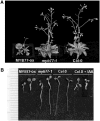
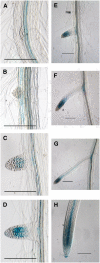

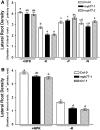
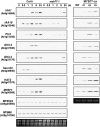
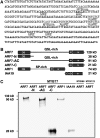
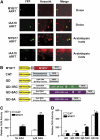


Similar articles
-
UV-B photoreceptor UVR8 interacts with MYB73/MYB77 to regulate auxin responses and lateral root development.EMBO J. 2020 Jan 15;39(2):e101928. doi: 10.15252/embj.2019101928. Epub 2019 Nov 28. EMBO J. 2020. PMID: 31777974 Free PMC article.
-
IAA8 involved in lateral root formation interacts with the TIR1 auxin receptor and ARF transcription factors in Arabidopsis.PLoS One. 2012;7(8):e43414. doi: 10.1371/journal.pone.0043414. Epub 2012 Aug 17. PLoS One. 2012. PMID: 22912871 Free PMC article.
-
A secreted peptide acts on BIN2-mediated phosphorylation of ARFs to potentiate auxin response during lateral root development.Nat Cell Biol. 2014 Jan;16(1):66-76. doi: 10.1038/ncb2893. Epub 2013 Dec 22. Nat Cell Biol. 2014. PMID: 24362628
-
Auxin response factors are keys to the many auxin doors.New Phytol. 2022 Jul;235(2):402-419. doi: 10.1111/nph.18159. Epub 2022 May 10. New Phytol. 2022. PMID: 35434800 Review.
-
Funneling auxin action: specificity in signal transduction.Curr Opin Plant Biol. 2004 Dec;7(6):687-93. doi: 10.1016/j.pbi.2004.09.006. Curr Opin Plant Biol. 2004. PMID: 15491917 Review.
Cited by
-
Fructan and hormone connections.Front Plant Sci. 2015 Mar 23;6:180. doi: 10.3389/fpls.2015.00180. eCollection 2015. Front Plant Sci. 2015. PMID: 25852727 Free PMC article. No abstract available.
-
Regulation of auxin transcriptional responses.Dev Dyn. 2020 Apr;249(4):483-495. doi: 10.1002/dvdy.139. Epub 2019 Dec 14. Dev Dyn. 2020. PMID: 31774605 Free PMC article. Review.
-
LATE MERISTEM IDENTITY2 acts together with LEAFY to activate APETALA1.Development. 2011 Aug;138(15):3189-98. doi: 10.1242/dev.063073. Development. 2011. PMID: 21750030 Free PMC article.
-
A kinetic analysis of the auxin transcriptome reveals cell wall remodeling proteins that modulate lateral root development in Arabidopsis.Plant Cell. 2013 Sep;25(9):3329-46. doi: 10.1105/tpc.113.114868. Epub 2013 Sep 17. Plant Cell. 2013. PMID: 24045021 Free PMC article.
-
Apoplastic reactive oxygen species transiently decrease auxin signaling and cause stress-induced morphogenic response in Arabidopsis.Plant Physiol. 2011 Dec;157(4):1866-83. doi: 10.1104/pp.111.181883. Epub 2011 Oct 17. Plant Physiol. 2011. PMID: 22007024 Free PMC article.
References
-
- Abel, S., Nguyen, M., and Theologis, A. (1995). The PS-IAA4/5-like family of early auxin-inducible mRNAs in Arabidopsis thaliana. J. Mol. Biol. 251 533–549. - PubMed
-
- Berleth, T., Krogan, N.T., and Scarpella, E. (2004). Auxin signals—Turning genes on and turning cells around. Curr. Opin. Plant Biol. 7 553–563. - PubMed
-
- Blakeslee, J.J., Peer, W.A., and Murphy, A.S. (2005). Auxin transport. Curr. Opin. Plant Biol. 8 494–500. - PubMed
-
- Blilou, I., Xu, J., Wildwater, M., Willemsen, V., Paponov, I., Friml, J., Heidstra, R., Aida, M., Palme, K., and Scheres, B. (2005). The PIN auxin efflux facilitator network controls growth and patterning in Arabidopsis roots. Nature 433 39–44. - PubMed
Publication types
MeSH terms
Substances
LinkOut - more resources
Full Text Sources
Other Literature Sources
Molecular Biology Databases

